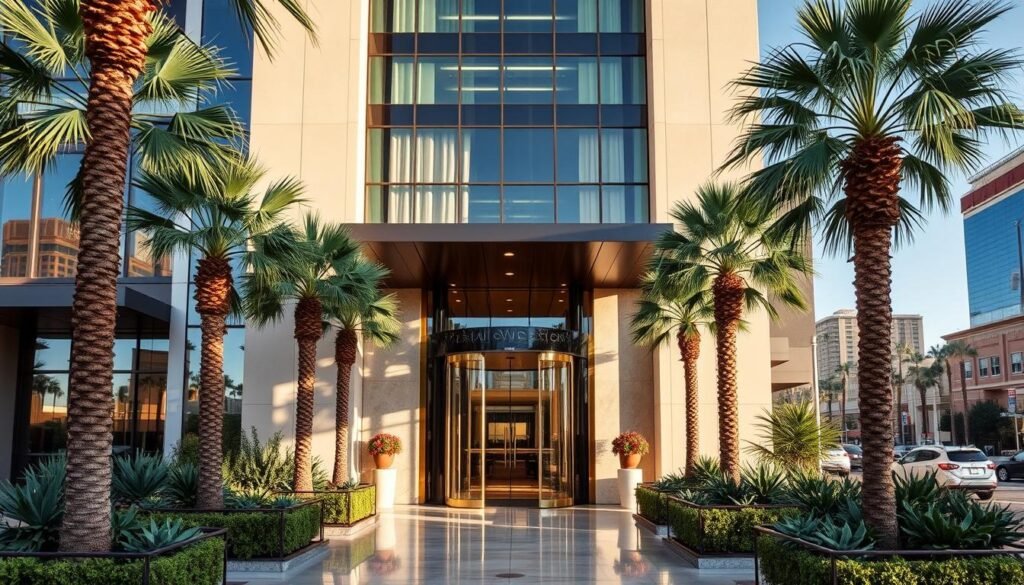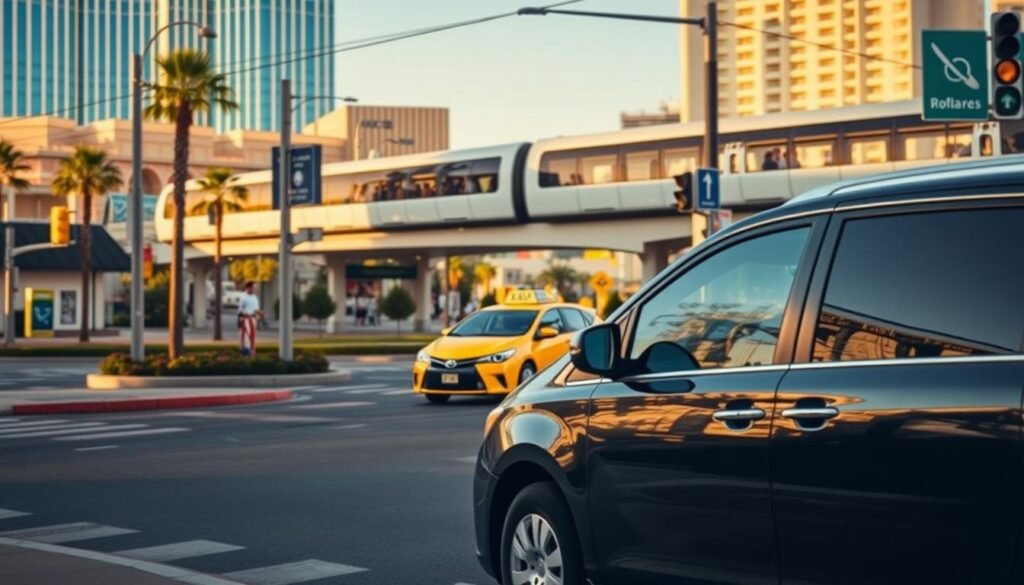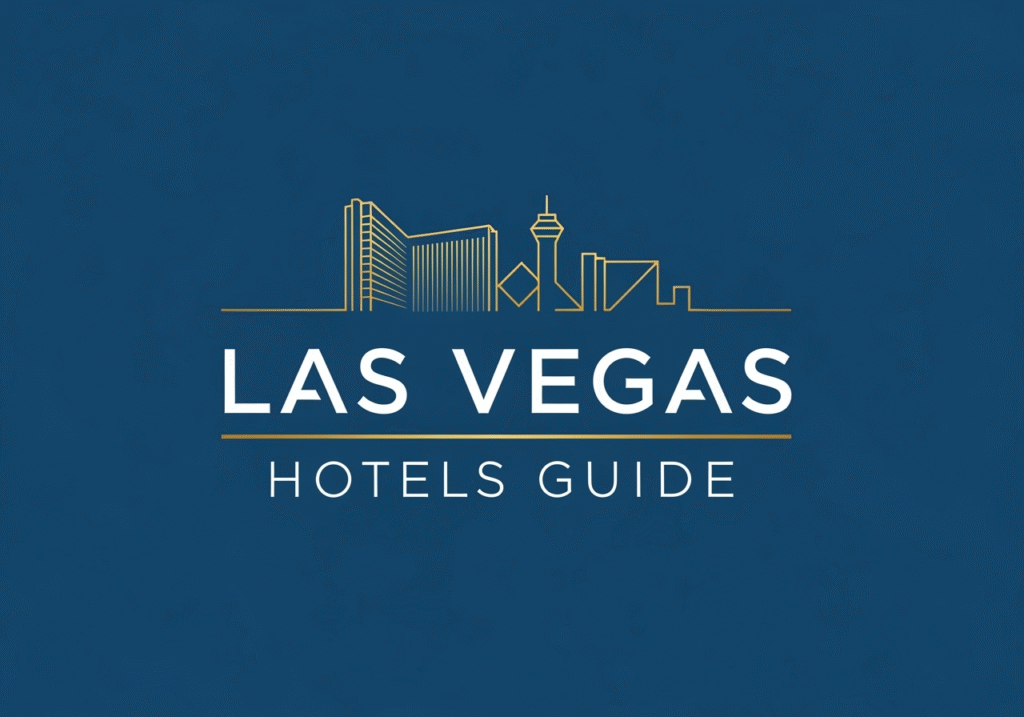I’ll show you how I lock a flexible reservation first, then keep chasing a better price—because your vegas trip shouldn’t hinge on a single search.
Midweek stays can feel like hitting a mini-jackpot. The same hotel and room that cost a fortune on Saturday can be hundreds cheaper on Tuesday. I’ll explain why and how to use that swing to your advantage.
I’ll walk you through avoiding big-event rate spikes, when to sign up for rewards (MGM, Caesars, Wynn), and why booking direct often wins upgrades and flexible cancellation. We’ll weigh Strip vs off-Strip options honestly—short rides, quieter lobbies, and real value at places like Virgin and Palms.
Quick wins: spot hidden fees, use transit hacks (Deuce, Monorail, free trams), and deploy respectful upgrade moves that actually work. Read on and you’ll be able to replicate my process from your couch.
Key Takeaways
- Midweek dates often yield much lower rates than weekends.
- Sign up for major rewards programs to earn perks and upgrades.
- Compare Strip and off-Strip options for value and vibe.
- Watch event calendars to avoid huge price spikes.
- Booking direct usually gives better service and flexibility.
Best time to book and when Vegas hotel rates drop
Pick your dates around demand dips and you’ll shave serious cash off the nightly rate. My rule of thumb: the softest windows each year are January, February, June, and August—think winter lows and summer heat when crowds thin out.
I go midweek whenever I can. A Tuesday night can be hundreds less than the same hotel on Saturday. Watch per-night rates and total fees, not just the base number listed on a site.
Events to avoid
Big conventions and festival weekends flip demand fast. CES (January), EDC (May), major holidays and big fight weekends make prices spike and inventory vanish.
Lock refundable rooms, recheck, rebook
Book a refundable reservation now and check daily. Many properties allow cancellation up to 72 hours before arrival. If the pricing drops, cancel and rebook—I’ve done it dozens of times and it pays off.
“Lock a flexible reservation, then chase better prices—small moves win big.”
- Slide dates by a day or two to cut costs on the same stay.
- Track one favorite site at the same time each day to spot late-afternoon adjustments.
Booking direct vs. OTAs: how to get the better deal
My first click is almost always the resort’s site—it’s where flexible fares and member discounts show up first. I check the refundable rate, then compare totals on other websites.

I consistently see booking direct beat big aggregators on refundable rates. Real checks showed Caesars $248 direct vs $265 OTA and Bellagio $296 vs $329. Those member pages at las vegas resorts quietly undercut splashy banners.
Free cancellation is the unsung hero. A refundable reservation (commonly 72 hours) lets you rebook if pricing drops. OTAs push non-refundable deals—skip them unless you’re certain.
“The better deal isn’t just a lower number—it’s control: rebook windows, upgrades, and talking to a human.”
- I sign up for MGM Resorts, Caesars Rewards, and Wynn Rewards before I price—instant discount shows up.
- Direct reservations often get easier changes at the desk and fewer view surprises.
- Keep screenshots of your rate; if the rate shifts on the site, call and adjust the reservation.
Loyalty programs and player cards that actually save you money
Sign up before you compare rates — those membership pages quietly shave dollars off the headline price. I register accounts early and link a card so my profile shows when I look at rates.
I focus on three programs: Caesars Rewards, mgm resorts and Wynn. Each one can trigger instant member-only pricing, targeted discount emails, or upgrade offers after a booking.
Tier matching is real. Caesars has matched status from other programs up to Diamond. Downtown spots like Plaza and Golden Nugget will sometimes mirror that. I’ve seen suite promos hit Wynn and smart suite discounts pop at MGM.
- I always register the card before I peek at prices—member pages often lower the total immediately.
- Link play or dining to your profile; those actions feed better targeted post-booking offers.
- Co-branded credit cards stack points and tier credits; small charges add up to free rooms or meals.
“Your profile is more powerful than a single coupon — it turns generic bookings into tailored offers.”
Keep email filters clean and act fast. Those upgrade windows are short and the best rooms vanish quickly at many vegas resorts and the occasional hotel casino.
Don’t overlook off-Strip and Downtown for value
If you want value without losing the action, off-Strip stays are my go-to move. I base near the buzz, not inside the crush.
Virgin Hotels, Palms, and Rio sit just off the main parade. Short ride times, calmer lobbies, and friendlier rates are common.

Downtown offers a different flavor—lower prices and character-packed blocks. Circa is the premium play: huge sportsbook, a destination pool, and electric nights.
I like splitting a trip: two nights off-Strip to save, two nights on the Strip to soak the spectacle. You often get bigger rooms per dollar and quieter mornings.
- Free or cheaper parking at Palms and Rio adds up over a few nights.
- Food scenes at these properties are legit—less walking, more local bites.
- Ride-share times are short; quick pivots keep the trip flexible.
“Base near the action without being swallowed by it.”
Want a short list of choices? See my picks for the best off-Strip hotels and plan a smarter stay.
Resort fees, parking, and hidden costs to watch before you click book
Before I hit confirm, I run the math on every extra charge the site sneaks in. A low nightly number can swell once resort fees, taxes, parking, and extra adult charges appear at checkout.
Who charges for parking—and where it’s still free
On the Strip, expect parking charges at MGM Resorts, Caesars, Wynn, Venetian, and Resorts World. Sahara and Treasure Island still offer free guest parking. Off-Strip options like Palms and Rio often include free parking. The Strat gives locals free access; downtown properties may validate, though Circa’s fees run higher.
Total trip math: resort fees, extra adults, taxes, and add-ons
I build a “true total” before I finalize any reservation. That means base rate + resort fees + taxes + parking + extra adult charges + add-ons.
- Screenshot every total page—proof if numbers change later.
- Check incidental holds so your card limit won’t trip at check-in.
- Sometimes a slightly higher nightly rate with lower fees saves you real money.
“A slightly higher nightly rate with lower fees can beat the ‘cheapest’ headline price once you do the math.”
| Charge | Typical Who | What to do |
|---|---|---|
| Resort fee | Most properties | Confirm line items and daily total before you pay |
| Parking | MGM, Caesars, Wynn, Venetian, Resorts World (charged) | Compare off-Strip or validated downtown options |
| Extra adult charge | Various hotels | Read the occupancy note and check checkout totals |
| Incidentals hold | All properties | Pad your card limit to avoid surprise declines |
If you rent a car, run a quick rideshare vs. parking cost test. Packages that include credits or parking can be a real win if you’ll use them.
Transportation choices that beat surge pricing and save time
Good transit choices turn commute time into extra dinner or show minutes—and save money, too.
I treat transit like a secret deal. The Deuce bus runs 24/7 along the las vegas strip, so it covers late nights and early mornings without surge fares.
The Las Vegas Monorail is my speed lane: weekdays roughly 7am–midnight and weekends until about 3am. Daily passes start near $15 and make hopping between stations painless.

How I use each option
- Deuce — 24/7 coverage; perfect when a show ends late or you need a low-cost transfer.
- Monorail — faster, fewer stops; ideal if your hotel sits near a station.
- Free trams — quick hops between resort clusters to skip long walks or taxi queues.
I pair transit with short walks. That combo beats surge pricing and shrinks wait times. I save rideshare for odd-hour jumps or far-flung dinners.
“Stations offer clean leading lines at golden hour—great editorial frames between rides.”
Use passes, stack trams, and you’ll turn travel time into extra moments to savor the city. Small moves like these are a real deal.
Upgrade tactics at and before check-in
A small, well-timed ask at the desk can turn a plain room into a memorable stay. I always start by booking a solid base room and then watching the property’s emails and availability.
Play the waiting game: targeted upgrade emails
Once the reservation is in the system, targeted offers often land in your inbox. These can include discounted suites or a bumped view for a modest per-night fee.
Pro move: accept a reasonable upgrade if it boosts your stay—sunrise coffee on a skyline-facing balcony is worth small splurges.
The $20 approach: etiquette and realistic asks
The old “$20 trick” still shows up, but keep expectations low. Ask politely and tip for service, not as a bribe. Aim for small wins—higher floor, quieter wing, or a nicer view—not instant suites.
Call ahead and use local numbers
Calling the hotel’s local desk before arrival can surface unpublished options. Managers sometimes have levers OTAs can’t touch.
- I prep my wish list: floor, quiet side, specific view—so the desk knows what I want.
- Late afternoon check-ins can score day-of inventory deals.
- If nothing opens at check-in, ask again the next day; rooms shift nightly.
“Be polite, specific, and ready to lock the upgrade if it actually improves your stay.”
Smart online booking workflow to compare prices the right way
I always clear my browser and run the same search on desktop and mobile to spot price gaps. That clean slate avoids dynamic targeting and shows true differences between engines.
Start by testing the same dates across a couple of trusted sites and the resort’s own pages. Log into loyalty before you refresh so member pricing appears. Track totals, not just a catchy nightly sticker.
Clear cookies, try mobile rates, and track totals across trusted sites
Clear cookies between sessions. Then price the same stay on phone and laptop—mobile rates sometimes differ from desktop. Watch base rate, resort fees, taxes, parking, and extra adult charges.
Quick workflow: build a simple grid with hotel, dates, base rate, fees, total. Take screenshots. Wait a day and recheck; prices often dip late afternoon.
Package deals and perks: when bundled air + hotel makes sense
Bundled packages can hide unpublished savings. If air is part of the trip, compare a package against separate components. Sometimes the package wins overall prices, but verify refund rules.
“A refundable plan gives you the breathing room to rebook if pricing moves.”
| Action | Why it matters | When to use | Outcome |
|---|---|---|---|
| Clear cookies & compare desktop/mobile | Prevents dynamic price jumps | Every search session | Accurate pricing view |
| Grid of totals (hotel, base, fees, total) | Keeps comparisons honest | Before final choice | Better value decision |
| Check resort site + OTAs | Member rates may appear on-site | Same session, logged in | Possible savings with booking direct |
| Price packages with airfare | May include unpublished discounts | If flight is needed | Lower overall trip cost |
- Stick to reputable websites and verify vendor trust before you pay.
- Avoid strict non-refundable fares unless plans are locked.
- Set calendar reminders to reprice weekly after your reservation.
Tips for booking las vegas hotels online: quick-hit checklist
A smart reservation routine saves cash and stress—start flexible, then chase better rates.
Book direct with a refundable rate (most allow 72-hour cancel). Lock a flexible reservation on the resort site, then recheck daily and rebook if the rates drop.
Scan the calendar and avoid big conventions and holiday spikes—CES, EDC, and fight weekends change everything.
Core moves I rely on
- Join loyalty first — instant member pricing can shave the total on a vegas hotel and improve upgrade odds.
- Always verify the total with fees, taxes, and parking before you confirm a reservation.
- Consider off-Strip options like Virgin, Palms, and Rio for a quieter, better-value stay.
- Plan transport: Deuce runs 24/7; Monorail is faster on weekdays (7am–midnight) and later on weekends.
- Compare at least one OTA and the hotel site, clear cookies, try mobile, set weekly alerts, and keep screenshots.
“Start flexible, watch prices, and act fast when a real deal appears.”
Visuals that convert: luxury hotel imagery and page presentation
When photos feel true and tactile, readers imagine themselves in the space. That moment turns curiosity into a real desire to stay.
Lead with editorial energy. Use magazine-level imagery that makes a hotel feel aspirational yet honest. Shoot lobbies, suites, and rooms at golden hour so materials glow and skin tones stay natural.
Photography style and trust
I aim for a Condé Nast Traveler vibe: editorial, tactile, and quietly luxurious. Wide establishers set the scene. Tight details sell texture—linen, brass, wood grain.
Technical specs that repeat reliably
Gear and settings: Canon EOS R5 with RF 24-70mm f/2.8L IS; f/4.0, ISO 100, 1/125s. Capture in 8K RAW and professionally grade to retain HDR detail.
Lighting and composition
Golden hour and subtle three-point fills keep exposures balanced. Use warm color temps (3500–4500K) and f/4 to hold foreground detail while layering depth.
“A hero view shot—correctly lit and composed—does more selling than a paragraph of praise.”
| Element | Why it matters | Practical setting |
|---|---|---|
| Hero wide | Establishes scale and view | 24–35mm, f/4, 8K RAW, golden hour |
| Detail vignettes | Conveys material quality | 70mm crop, low ISO, soft fill light |
| Suite flow shots | Shows how spaces connect | Multi-frame pano, consistent white balance |
| Lobby establishers | Build trust and brand tone | Rule of thirds, leading lines, straight verticals |
- Keep horizons true—architectural precision matters.
- Mix ambient window light with discreet fills in rooms.
- Show the view that guests will wake to—it’s a silent promise.
Final note: honest styling and technical rigor make a resort page feel credible. Great images cut doubt and nudge bookings by selling a believable experience.
Conclusion
I end every search day with one rule: lock a refundable room and hunt the rate until it drops. That simple loop is the fastest path to a better deal on a las vegas stay.
Direct bookings usually win—example checks at Caesars Palace, Wynn, and Bellagio showed lower totals and friendlier change windows. Most refundable fares let you cancel up to 72 hours pre-arrival, so you keep control.
Shift dates, lean off-Strip, and use transit to dodge surge prices. Stack your card and loyalty so upgrade emails and suite offers find you. Last minute walk-ups often cost more—inventory thins and prices climb.
Book with intention, travel curious, and let a cinematic dusk hero image of a flagship resort set the mood before you check in.
FAQ
When is the best time to book a room on the Strip to get lower rates?
Midweek stays usually offer the lowest nightly prices — think Tuesday through Thursday. Summer daytime heat and early winter can also drop rates as demand softens. Avoid major conventions and holiday weekends when hotels push prices up.
Which months and days typically have the cheapest rooms?
The slowest months are often July and August (due to heat) and parts of winter outside holiday periods. Weeknights are cheaper than weekends. I watch midweek inventory closely and lock refundable reservations when I see a deal.
What big events should I avoid if I want lower rates?
Large conventions like CES, music festivals such as EDC, big UFC or boxing fight weekends, and major holidays spike demand. Check event calendars for Allegiant Stadium and the Convention Center before finalizing dates.
Should I book a refundable room now and rebook if prices drop?
Yes — that’s a smart move. Book refundable or flexible rates directly, then monitor prices. If a lower nonrefundable rate appears, cancel and rebook. Many properties also offer price-drop protection when you call.
Is it better to reserve directly with the resort or use an OTA?
I usually book direct. Resorts like Caesars Palace and MGM Grand often match or beat OTA prices and add perks — free cancellation, upgrades tied to loyalty accounts, and easier customer service. Use OTAs for price checks and timing comparisons.
Do direct bookings come with real benefits over travel sites?
Yes. Direct bookings commonly include flexible rebooking, waived change fees during promotions, and direct access to property offers. Plus, you earn loyalty points and can receive targeted upgrade emails after you reserve.
How do loyalty programs actually save money on a first trip?
Sign up for Caesars Rewards, MGM Rewards, or Wynn Rewards before you book. Even entry-level memberships unlock member rates, occasional free nights, and email-only discounts. Some programs match status from competitors, too.
Are off-Strip or Downtown properties a good value compared to the Strip?
Absolutely. Places like Virgin Hotels, Palms, and Rio often have lower rates and less crowding, yet they’re a short ride from the Strip. Downtown Las Vegas usually offers the best value — with Circa as a pricier, high-end exception.
What hidden costs should I factor into the nightly rate?
Always add resort fees, parking charges, local taxes, and any extra-person fees to your nightly math. Some hotels still charge for self-parking; others include it. These extras can change a bargain into a full-price stay fast.
Which properties still offer free parking on the Strip?
Policies shift, but some off-Strip and select downtown hotels maintain free parking. Always confirm current parking fees directly with the property before booking to avoid surprises at check-in.
What transportation options save time and money around the Strip?
The Las Vegas Monorail, RTC Deuce bus, and complimentary resort trams can beat ride-share surge pricing. Passes for the monorail and day passes for the Deuce are handy if you plan multiple trips across the corridor.
How can I score an upgrade before or at check-in?
Join the hotel’s loyalty program, mention special occasions, and check for targeted offers after booking. Calling the property’s local front desk or a reservations manager 24–48 hours before arrival sometimes reveals unpublished upgrades.
Is tipping or offering cash ever a good upgrade tactic?
A modest, polite tip for bell staff or a friendly chat at check-in can help — but don’t expect guaranteed results. Be realistic and courteous; managers control room inventory and upgrades more than tips do.
What’s the best online workflow to compare room prices effectively?
Clear cookies or use private browsing, compare mobile and desktop rates, and track total out-the-door prices (including resort fees). Cross-check trusted OTAs with direct sites, and use alerts to watch for drops.
When do package deals (air + hotel) make sense?
Bundles are worth it when airfare is high or when the package includes valuable extras like resort credits. If you’re flexible with dates and airlines, compare standalone rates before committing to a package.
Any quick checklist to follow before I hit reserve?
Book a refundable direct rate, verify resort fees and parking, join loyalty programs, avoid big-event dates, consider off-Strip options, and plan transport. Monitor prices after booking and rebook if a lower total appears.
How much does great hotel photography influence my choice online?
Very much. High-quality images — editorial style, warm lighting, and sharp composition — build trust and set correct expectations. I pick rooms that match the photos closely to avoid surprises on arrival.
What camera specs and lighting should hotels use to make rooms look accurate but appealing?
Professional photos often use full-frame cameras like the Canon EOS R5, HDR-balanced exposures, and golden-hour or soft artificial lighting to show true color and depth. That level of craft helps me trust the listing’s visuals.














